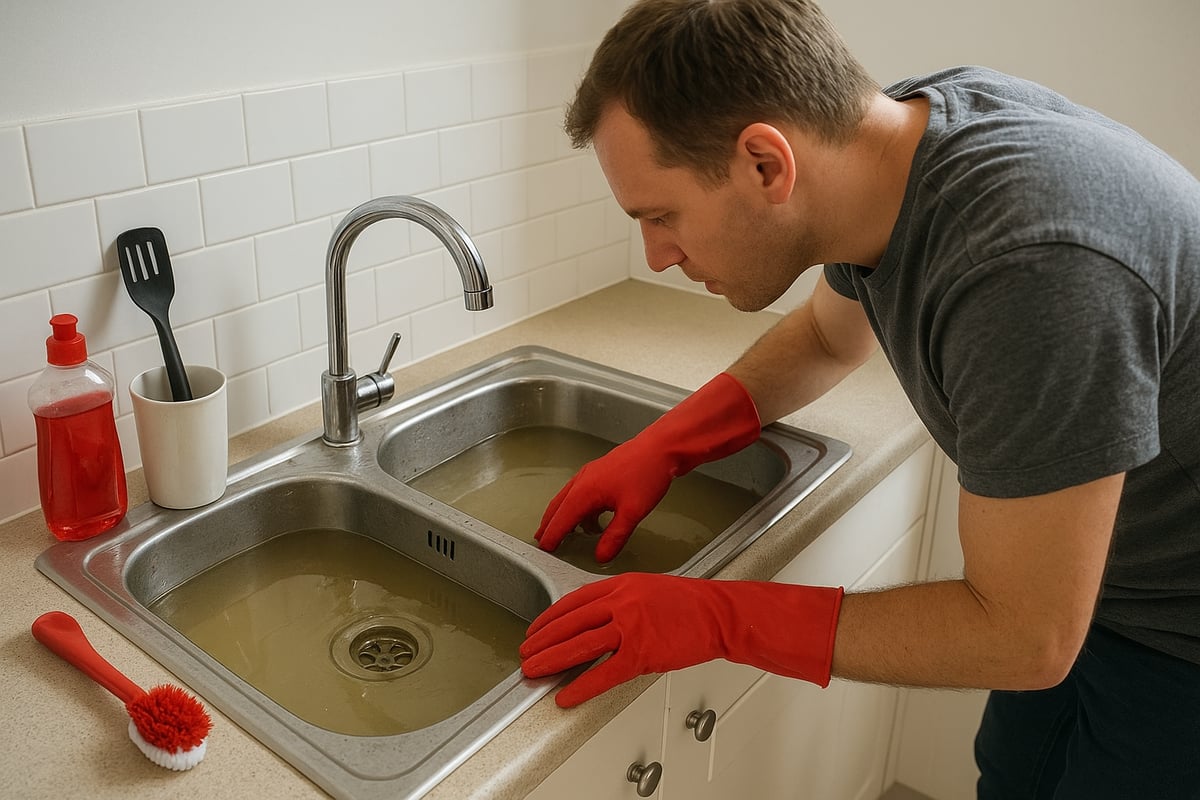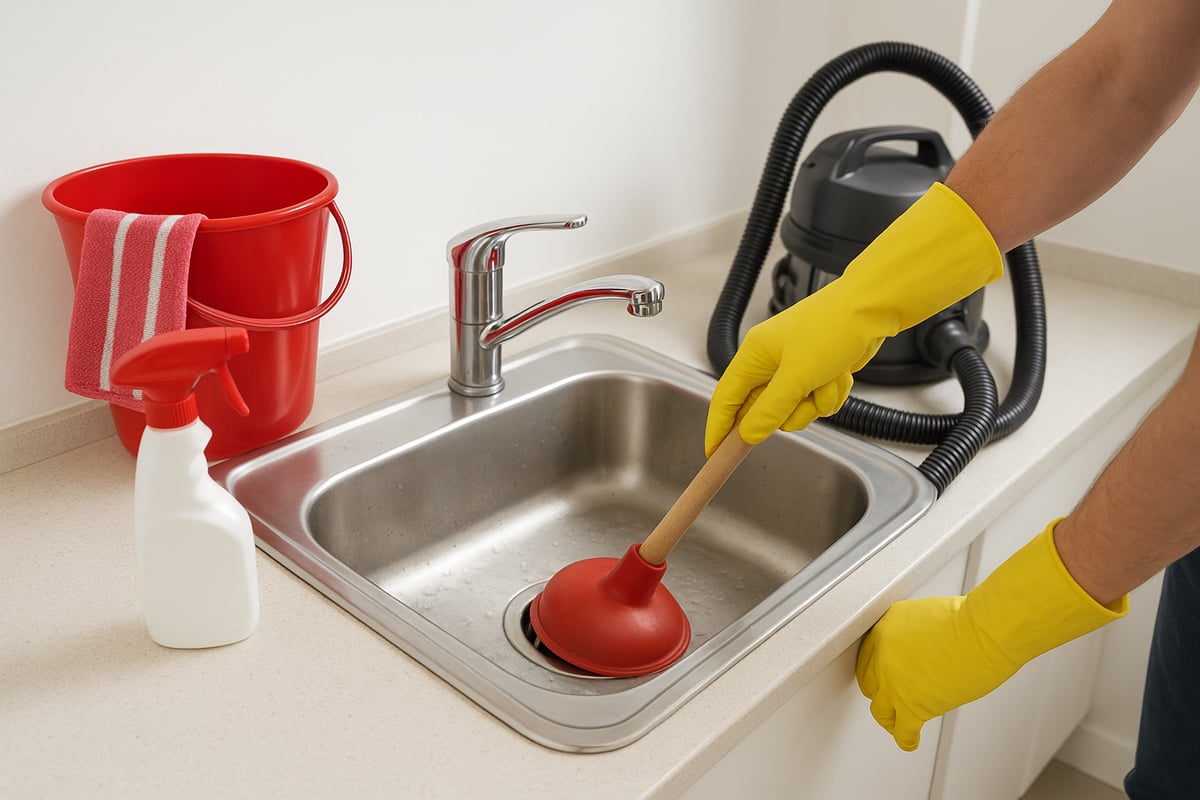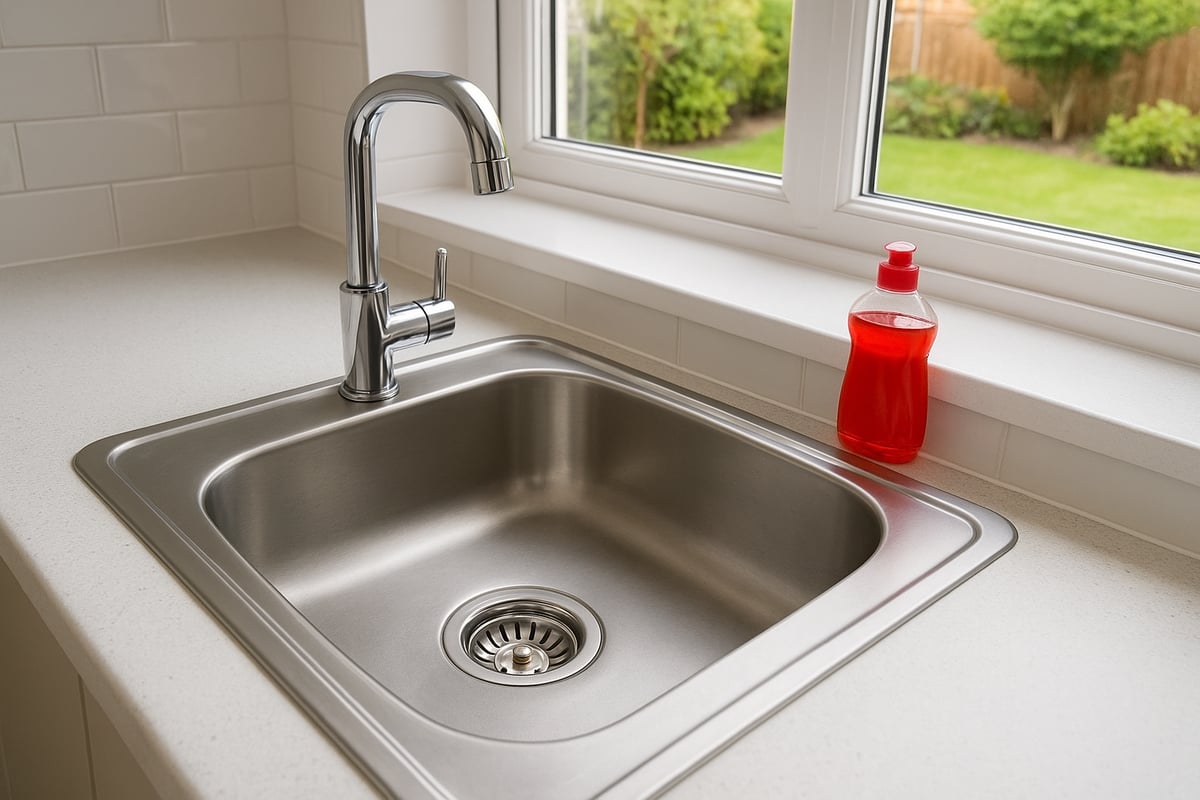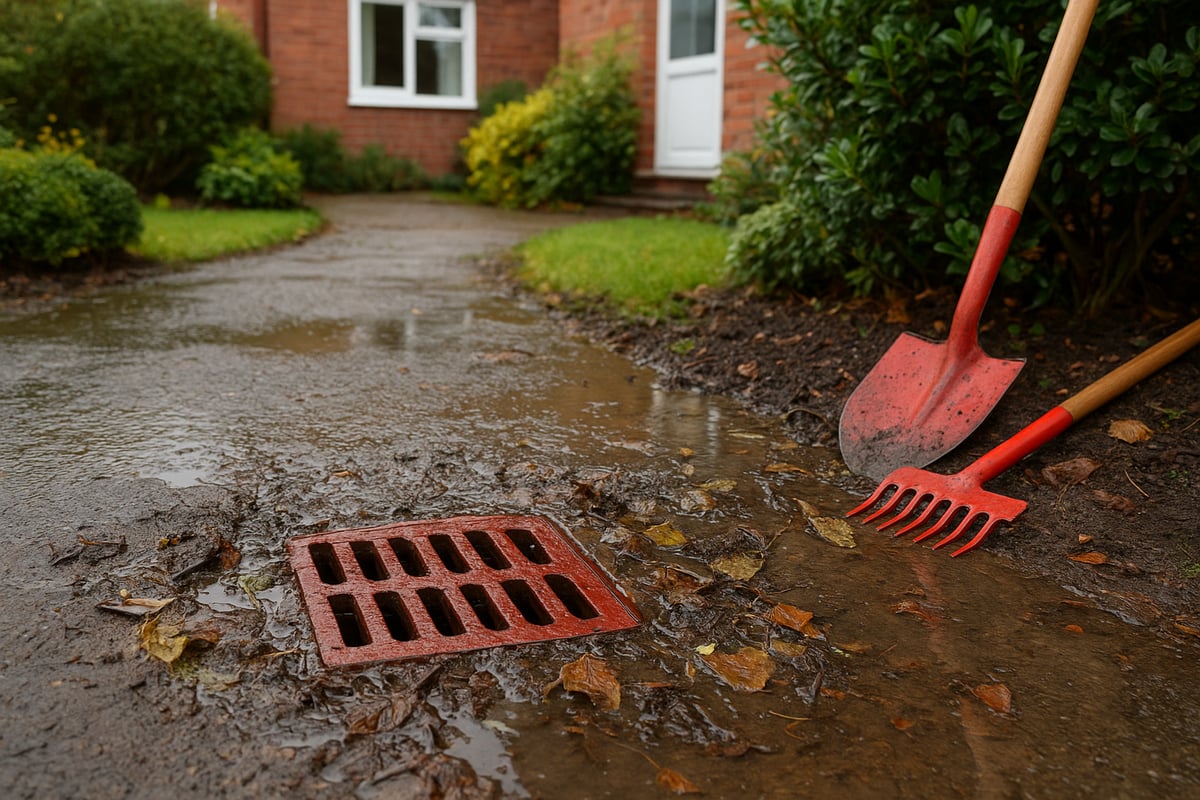Unblock Drainage: The Essential Guide for Homeowners 2025
Imagine waking up to a flooded kitchen or a persistent foul smell drifting from your sinks. For many homeowners, these are more than minor annoyances—they are signs of drainage problems waiting to escalate. In fact, over 60% of UK homes face drainage issues every year.
This essential 2025 guide is designed to help you unblock drainage with confidence and prevent future headaches. You will find practical steps, expert advice, and the latest solutions tailored for domestic properties.
Ready to take control? We will walk you through the causes, hands-on unblocking methods, prevention strategies, when to seek professional help, and what’s new for 2025.
Understanding Drainage Blockages: Causes and Warning Signs
Blocked drains are a common yet disruptive problem for UK homeowners. Whether it is a slow draining sink or an unpleasant odour in the kitchen, the need to unblock drainage quickly becomes clear. Understanding what causes these blockages and recognising early warning signs is essential for maintaining a healthy home environment.

Introduction to Drainage Blockages
Drainage systems in UK homes are under constant pressure from daily use. Blockages do not happen overnight, but rather build up as materials accumulate in pipes. Homeowners often encounter issues that require them to unblock drainage, particularly in older properties or busy households.
Major Causes in UK Homes
The most frequent culprits behind blockages are hair, grease, food waste, wet wipes, and tree roots. Wet wipes, despite being labelled as flushable, are responsible for a significant proportion of blockages. Grease and fat solidify in pipes, while hair and food waste create stubborn clogs.
Modern lifestyles can make things worse. Increased use of personal care products, convenience foods, and improper disposal habits all contribute to the need to unblock drainage more frequently. According to UK drainage blockage statistics 2017, these issues lead to hundreds of thousands of callouts every year.
Common Causes Table
| Cause | Typical Location | Symptom |
|---|---|---|
| Hair | Bathroom sinks, showers | Slow draining water |
| Grease/Fat | Kitchen sinks | Foul odours |
| Wet wipes | Toilets | Blocked toilets |
| Tree roots | External drains | Water backing up |
Spotting the Warning Signs Early
Early detection is vital for any homeowner looking to unblock drainage before a minor issue becomes a costly repair. Watch for these warning signs:
- Water draining slowly from sinks, baths or showers
- Gurgling noises coming from pipes
- Persistent unpleasant smells, especially near sinks or floor drains
- Water backing up in appliances or toilets
If you notice any of these, act quickly to prevent further damage.
The Impact of Hard Water and Ignoring Symptoms
Regions like Kent suffer from hard water, which accelerates scale build-up inside pipes. This mineral deposit narrows the pipe diameter, making it easier for debris to get stuck. Homeowners in hard water areas must remain vigilant and ready to unblock drainage more often than those in softer water regions.
Ignoring the early warning signs can result in property damage, unpleasant living conditions, and expensive repairs. Damp, mould, and even structural issues may arise if blockages are left untreated.
Understanding Internal vs. External Blockages
Internal drain blockages typically occur within your property, affecting sinks, baths or toilets. External blockages are usually found in outdoor drains, gullies or underground pipes and often involve soil, leaves, or root ingress.
Older properties with clay or cast iron pipes are at higher risk. Modern plastic pipes are more resistant, but poor installation or ground movement can still lead to problems. Understanding where and why you need to unblock drainage helps you target the right solution and avoid recurring issues.
Step-by-Step Guide: How to Unblock Your Drain Safely
A blocked drain can disrupt your entire household, but with the right approach, you can often restore flow quickly and safely. This step-by-step guide will help you assess the problem, try proven DIY techniques, and understand when it's time to seek expert help. Whether you are dealing with a slow-draining sink or a stubborn toilet, learning how to unblock drainage is essential for every UK homeowner.

Assess the Situation: Identify the Source
Before you attempt to unblock drainage, it is vital to identify the source of the problem. Start by checking whether the blockage is localised to one fixture, like a sink or toilet, or if it affects multiple areas in your home. If more than one drain is slow or backing up, you may have an issue in the main drainage pipe.
Take these safety precautions before starting:
- Wear rubber gloves and old clothing.
- Ensure good ventilation, especially if using cleaning agents.
- Keep children and pets away from the affected area.
A quick assessment flow:
- Is only one fixture blocked? Try DIY.
- Are multiple fixtures affected? Main drain may be blocked.
- Is sewage backing up or flooding present? Avoid DIY and call a professional.
Never attempt to unblock drainage yourself if you notice foul sewage smells, water rising from multiple drains, or severe flooding. These situations can pose health risks and require expert intervention.
Basic DIY Methods for Minor Blockages
For minor issues, several DIY methods can help you unblock drainage quickly and safely. Boiling water is often effective for grease build-up; simply pour it slowly down the drain in stages. For sinks and toilets, use a plunger, making sure to seal the opening fully and use firm, repeated motions to create suction.
Another gentle option is the baking soda and vinegar method:
- Pour half a cup of baking soda into the drain.
- Add half a cup of vinegar and cover the drain.
- Wait 30 minutes, then flush with hot water.
Drain snakes are excellent for dislodging hair or debris. Insert the snake, twist, and pull out the blockage. According to UK surveys, plungers and baking soda methods resolve over 60% of minor domestic blockages.
Remember, always approach these tasks with patience and care to successfully unblock drainage without damaging pipes.
Advanced DIY Solutions for Stubborn Drains
If basic techniques fail, more advanced solutions may be required to unblock drainage. A wet/dry vacuum can extract stubborn clogs from deep within pipes. For bathroom sinks, you can carefully remove and clean the U-bend or trap—place a bucket underneath, unscrew the trap, and clear out debris before reattaching.
Enzyme-based drain cleaners are a safer, eco-friendly choice compared to harsh chemicals. These products use natural enzymes to break down organic matter over time.
Follow these best practices:
- Avoid using excessive force, which can damage pipes.
- Always reassemble fixtures tightly to prevent leaks.
- Test the drain after cleaning to confirm the blockage is resolved.
A step-by-step example: To clean a bathroom sink trap, unscrew the trap, remove debris, rinse thoroughly, and secure it back into place. This approach often helps unblock drainage when other methods fail.
When to Call a Professional
There are times when attempting to unblock drainage yourself is not advisable. If you experience recurring blockages, foul sewage smells, or water backing up from multiple drains, the problem may extend beyond your reach. DIY attempts on main drains or sewage lines can be risky and may cause further damage.
Professional drainage experts use advanced tools such as CCTV inspections and high-pressure jetting to diagnose and resolve complex clogs. Typical costs for professional unblocking in 2025 range from £80 to £200, depending on the severity and location.
For example, a Kent homeowner faced repeated blockages in their external drains. After failed DIY attempts, they called in experts who identified tree root ingress and cleared the obstruction efficiently. If you need help, consider Professional drainage services in Kent for trusted solutions.
Knowing when to seek professional help ensures your drainage system remains safe and functional, preventing costly repairs down the line.
Preventing Future Drain Blockages: Best Practices for 2025
Preventing issues before they start is the most effective way to unblock drainage and avoid disruption to your home. By adopting practical habits, making the most of cutting-edge products, and scheduling regular maintenance, you can protect your property from the stress and expense of recurring blockages.

Everyday Habits for a Healthy Drainage System
Simple, consistent habits are your first line of defence to unblock drainage and maintain a healthy system. Start by never flushing wipes, cotton buds, or sanitary products, as these can quickly cause stubborn clogs. Avoid pouring cooking oil, grease, or coffee grounds down the kitchen sink, since they harden and trap other debris inside pipes.
Install drain guards or strainers in sinks, showers, and baths. These devices catch hair, food particles, and other solids before they reach your pipes. Make it a habit to empty strainers into the bin daily.
Create a routine cleaning checklist:
- Wipe down plugholes and remove visible debris weekly
- Pour hot water down sinks to dissolve minor grease build-up
- Use a mix of baking soda and vinegar monthly for a chemical-free clean
By sticking to these small steps, you will greatly reduce the need to unblock drainage in the future and keep your plumbing running smoothly.
Modern Technologies and Products for Prevention
Embracing new solutions can make it easier to unblock drainage and prevent future problems. Smart drain monitors are now available in the UK, detecting slow-flow or blockages and alerting you via your phone. These sensors help you respond early, preventing minor issues from becoming major incidents.
Enzyme-based drain maintenance products offer a safe and eco-friendly way to keep pipes clear. Unlike harsh chemicals, these products use natural enzymes to break down organic material, reducing the risk of damage to your plumbing and the environment.
For homes in hard water areas, such as Kent, installing a water softener can minimise limescale build-up inside pipes. This reduces the chances of blockages caused by mineral deposits.
Here is a comparison of popular maintenance options:
| Product/Tech | Key Benefit | Eco-Friendly | Smart Alerts |
|---|---|---|---|
| Drain Guard/Strainer | Blocks debris | Yes | No |
| Enzyme Cleaner | Breaks down organic waste | Yes | No |
| Smart Drain Monitor | Early warning for blockages | Yes | Yes |
| Water Softener | Prevents limescale | Yes | No |
By integrating these modern solutions, you can proactively unblock drainage and keep your home’s plumbing in top condition.
Seasonal and Annual Maintenance Tips
Regular maintenance is crucial to ensure you never need to unblock drainage in a crisis. In autumn, clean gutters and downpipes to prevent leaves and debris from washing into external drains. This step is vital before winter, when blockages can lead to flooding or ice damage.
Keep an eye on garden plants and trees, trimming roots that may grow towards pipes. Schedule an annual inspection of your property’s drainage system, especially in older homes where pipe material may be more prone to corrosion or collapse.
Signs such as slow drainage, recurring odours, or visible leaks mean it is time for a professional check. Staying proactive with a maintenance plan will save you money and stress.
For a comprehensive approach, consider using an annual home maintenance checklist to help you track essential drainage tasks throughout the year. This ensures you never miss crucial steps and keeps your system clear.
External Drainage Issues: Gardens, Driveways, and More
Outdoor drainage is often overlooked until problems arise. Leaves, soil, garden debris, and even tree roots can quickly cause issues that lead homeowners to search for how to unblock drainage. Understanding these external threats is essential for maintaining a healthy system year-round.

Common Causes of Outdoor Drain Blockages
Outdoor drains are vulnerable to a variety of blockages. The most frequent culprits include fallen leaves, mud, gravel from driveways, and invasive tree roots. During autumn, leaf build-up can be rapid and persistent. In gardens with large trees, root systems may infiltrate pipes, making it challenging to unblock drainage without specialist tools.
Other causes include grass clippings, garden waste, and soil washed into gullies after heavy rain. Even small stones and silt can accumulate over time, restricting water flow and increasing the likelihood of flooding during storms.
Garden Design and Landscaping Impact
Your garden’s layout plays a significant role in drainage efficiency. Sloped lawns, paved driveways, and poorly positioned flower beds can direct water towards drains, overwhelming them with debris. Hard surfaces, such as patios and tarmac, prevent water from soaking into the ground, forcing more runoff into gullies.
To help unblock drainage and prevent future issues, consider permeable paving and well-placed drainage channels. Proper landscaping choices, like planting shrubs away from drains, also reduce the risk of root ingress and blockages.
Identifying and Clearing Blocked Gullies, Soakaways, and Channel Drains
Early detection is vital. Signs of a blocked outdoor drain include slow water runoff, standing puddles, and unpleasant smells near gullies. If you notice water pooling around your driveway or patio after rain, it may be time to unblock drainage in those areas.
To address minor blockages, remove debris from the drain cover and use a garden hose to flush the system. For stubborn blockages, a drainage rod or wet vacuum may be necessary. Always wear gloves and take care to avoid damaging pipework.
Surface Water Drainage and Flood Prevention
Surface water flooding is a growing concern, particularly in areas prone to heavy rainfall. Blocked drains can cause water to back up, increasing the risk of property damage. Installing surface water channels, soakaways, and regular maintenance helps unblock drainage and prevent localised flooding.
According to the UK Environment Agency, thousands of homes are at risk each year due to surface water mismanagement. A proactive approach, including regular clearing and strategic landscaping, can significantly reduce these risks.
Legal Responsibilities for Homeowners
Homeowners in the UK are legally responsible for maintaining private drains within their property boundaries. Failing to unblock drainage can lead to disputes, fines, or even insurance issues. It’s also essential to comply with sustainable drainage regulations, which promote practices that reduce flood risk and environmental impact.
For guidance on best practices and compliance, consult the National standards for sustainable drainage systems (SuDS), which outline effective strategies for managing outdoor drains and runoff responsibly.
Step-by-Step: Clearing a Blocked Garden Gully
- Put on gloves and safety glasses.
- Remove the drain cover carefully.
- Scoop out visible debris, such as leaves and silt.
- Flush the gully with water from a hose.
- Use a drainage rod if the blockage persists.
- Replace the cover securely.
By following these steps, you can often unblock drainage without professional help, keeping your garden safe from water damage.
When to Call a Professional and Flood Statistics
If you experience recurring blockages, foul odours, or water backing up into the house, it’s time to consult an expert. Professionals use CCTV inspections and high-pressure jetting to unblock drainage systems efficiently.
According to recent UK data, surface water flooding accounts for a significant portion of annual property claims. Prompt action and regular maintenance can save you from costly repairs and long-term damage.
Drainage Regulations and Homeowner Responsibilities in the UK
Understanding your legal duties before you unblock drainage is crucial for every UK homeowner. Regulations have evolved, and knowing the rules can save you from costly mistakes or disputes. In 2025, new updates have clarified responsibilities, making it more important than ever to stay informed if you want to unblock drainage safely and legally.
Private vs. Public Drains: Who Is Responsible?
When you attempt to unblock drainage, it is vital to know if the affected pipework is your responsibility. In most cases, drains within your property boundary are private, meaning you must maintain and unblock drainage yourself. However, sewers and some shared drains, especially those outside your boundary, are managed by your local water company.
Here is a quick summary:
| Drain Type | Who Maintains It? | Typical Location |
|---|---|---|
| Private Drains | Homeowner | Within property boundary |
| Shared Drains | Water company (post-2011) | Outside/serving multiple homes |
| Public Sewers | Water company | Public land/streets |
If you are unsure whether you need to unblock drainage or call your water provider, check your property deeds or contact your local authority.
Neighbours, Shared Drains, and Disputes
Problems can arise when you unblock drainage that connects to a shared system, especially if blockages affect neighbours. If your actions cause a blockage in a shared or public drain, you could be liable for repairs. For example, a Kent homeowner once tried to unblock drainage in their garden, only to discover the blockage was in a shared pipe, leading to a dispute with neighbours over repair costs.
If your blockage affects others, communicate promptly and involve your water company. Insurance may cover some repairs, but only if you have maintained your drains properly. Always keep records of maintenance or professional callouts when you unblock drainage.
Staying Compliant: Maintenance and Legal Updates
Staying compliant with UK drainage laws is essential to avoid fines or insurance issues. The Water (Special Measures) Act 2025 introduced stricter requirements for regular inspection and reporting of private drains. Homeowners are now expected to keep drains clear and ensure no prohibited items are flushed or poured away.
Regular actions to stay compliant:
- Inspect your drains at least once a year
- Avoid flushing wipes, fats, or oils
- Use professionals for difficult jobs
- Check for shared drains on your property
Interested in how people across the UK handle these duties? The UK Drainage Habits Survey 2025 provides valuable insights and practical advice on how to unblock drainage responsibly.
Resources for Kent and UK Homeowners
If you need help to unblock drainage or understand your obligations, contact your local council or water company. Many provide free guidance and can clarify whether your issue is private or public. For shared drains, consult your property documents or seek legal advice in case of disputes.
Understanding and following regulations is the foundation for safe, effective drainage maintenance. With the right knowledge, you can unblock drainage, avoid legal trouble, and protect your property for years to come.
Innovations and Future Trends in Drain Unblocking (2025 and Beyond)
Modern homeowners face ever-evolving drainage challenges. As products, habits, and climate patterns shift, the industry is rapidly developing new ways to unblock drainage efficiently and safely. Staying ahead of these trends is crucial to maintaining a healthy home environment.
Cutting-Edge Tools and Techniques
Professional drain specialists are now using advanced methods to unblock drainage, such as high-pressure water jetting and CCTV inspections. These technologies allow for precise identification and removal of stubborn blockages without invasive digging. High-pressure jetting, for example, blasts away debris and scale, restoring full flow quickly.
CCTV drain surveys provide real-time visuals inside pipes, helping experts pinpoint issues and recommend targeted solutions. For persistent clogs or system maintenance, services like powerflushing and pipe cleaning are growing in popularity, offering a thorough clean for both residential and commercial properties.
Eco-Friendly Solutions and Smart Technology
Environmental concerns are driving a shift towards sustainable ways to unblock drainage. Enzyme-based cleaners and non-toxic treatments are replacing harsh chemicals, making routine maintenance safer for homes and the planet. Smart home devices are also transforming drainage care. Sensors can now detect slow flow or rising water in pipes, sending instant alerts to homeowners before a minor issue becomes a major headache.
These connected systems can even automate preventative flushing or maintenance schedules, ensuring blockages are dealt with proactively. This combination of eco-friendly products and smart automation is shaping the future of domestic drainage.
Changing Habits, Climate Impact, and the Decade Ahead
Homeowner habits are adapting to new technologies. With more awareness of what should not enter drains, and easier access to maintenance tools, blockages are expected to decrease over time. Product design is also evolving, with self-cleaning pipes and anti-blockage coatings on the horizon.
Climate change is another key factor. Increased rainfall and flooding in the UK are placing extra pressure on drainage systems. Smart monitoring and regular professional maintenance will become even more essential to unblock drainage effectively and prevent property damage.
Consider the example of a smart home in Kent, where a sensor detected a slow drain in the kitchen. The homeowner received an alert, scheduled a professional check, and avoided a costly flood. Over the next decade, experts predict that such integrated solutions will become standard, blending convenience, sustainability, and resilience.
Homeowners who embrace these innovations will be best equipped to unblock drainage swiftly and protect their properties from future issues.
After learning how to spot early warning signs and tackle common drainage issues, you know that a proactive approach is essential for keeping your home safe and comfortable. Whether you’re dealing with a stubborn blockage or simply want to stay ahead with regular maintenance, it helps to have trusted experts on your side. At Castle Heating Kent, our experienced team has supported homeowners across Kent for years with reliable, professional plumbing solutions. If you’re ready for peace of mind—whether it’s unblocking drains or maintaining your entire system—we’re here to help.
Keeping Homes in and around kent Warm, Dry & Flowing Book with castle heating kent

